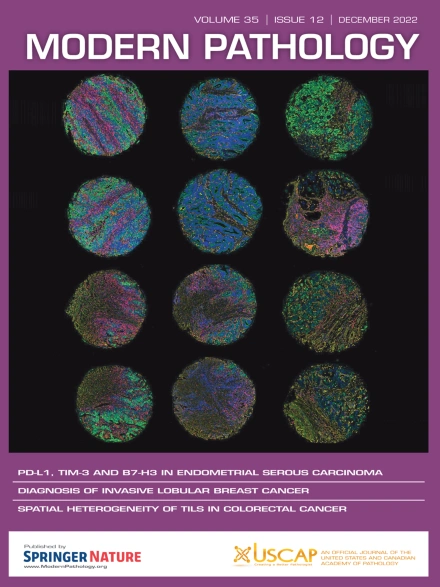A Multicenter Study on Intraoperative Glioma Grading via Deep Learning on Cryosection Pathology
IF 7.1
1区 医学
Q1 PATHOLOGY
引用次数: 0
Abstract
Intraoperative glioma grading remains a significant challenge primarily due to the diminished diagnostic attributable to the suboptimal quality of cryosectioned slides. Precise intraoperative diagnosis is instrumental in guiding the surgical strategy to balance resection extent and neurologic function preservation, thereby optimizing patient prognoses. This study developed a model for intraoperative glioma grading via deep learning on cryosectioned images, termed intraoperative glioma grading on cryosection (IGGC). The model was trained and validated on The Cancer Genome Atlas data sets and 1 cohort ( = 1603 and = 628), and tested on 5 cohorts ( = 213). The IGGC model achieved an area under the receiver operating characteristic curve value of 0.99 in differentiating between high-grade glioma and low-grade glioma, and an area under the receiver operating characteristic curve value of 0.96 in identifying grade 4 glioma. Integrated into the clinical workflow, the IGGC model-assisted pathologists of varying experience levels in reducing interobserver variability and enhancing diagnostic consistency. This integrated diagnostic model possesses the potential for clinical implementation, offering a time-efficient and highly accurate method for the 3-grade classification of adult-type diffuse gliomas based on intraoperative cryosectioned slides.
基于冷冻切片病理深度学习的术中胶质瘤分级多中心研究
术中胶质瘤分级仍然是一个重大挑战,主要是由于冷冻切片质量不佳导致诊断减少。准确的术中诊断有助于指导手术策略,平衡切除范围和神经功能的保留,从而优化患者预后。本研究通过对冷冻切片图像的深度学习开发了术中胶质瘤分级模型,称为IGGC。该模型在The Cancer Genome Atlas (TCGA)数据集和1个队列(ntrain = 1603, nvalidate = 628)上进行训练和验证,并在5个队列(ntest = 213)上进行测试。IGGC模型鉴别高级别胶质瘤(HGG)和低级别胶质瘤(LGG)的AUC值为0.99,鉴别4级胶质瘤的AUC值为0.96。IGGC模型集成到临床工作流程中,帮助不同经验水平的病理学家减少观察者之间的差异,提高诊断的一致性。这种综合诊断模型具有临床应用的潜力,为基于术中冷冻切片的成人型弥漫性胶质瘤的三级分类提供了一种高效、高精度的方法。
本文章由计算机程序翻译,如有差异,请以英文原文为准。
求助全文
约1分钟内获得全文
求助全文
来源期刊

Modern Pathology
医学-病理学
CiteScore
14.30
自引率
2.70%
发文量
174
审稿时长
18 days
期刊介绍:
Modern Pathology, an international journal under the ownership of The United States & Canadian Academy of Pathology (USCAP), serves as an authoritative platform for publishing top-tier clinical and translational research studies in pathology.
Original manuscripts are the primary focus of Modern Pathology, complemented by impactful editorials, reviews, and practice guidelines covering all facets of precision diagnostics in human pathology. The journal's scope includes advancements in molecular diagnostics and genomic classifications of diseases, breakthroughs in immune-oncology, computational science, applied bioinformatics, and digital pathology.
 求助内容:
求助内容: 应助结果提醒方式:
应助结果提醒方式:


